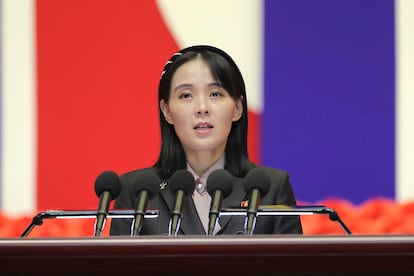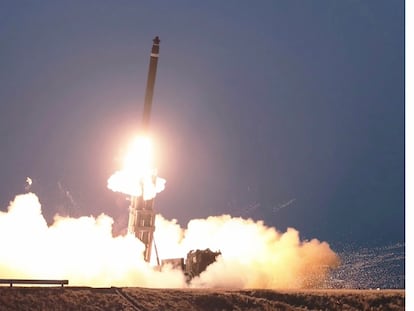Kim’s sister warns N. Korea ready to act against US, South
In a separate statement Tuesday, North Korea’s Foreign Ministry called the flyover of the U.S. B-52 bomber a reckless provocatio

The influential sister of North Korea’s leader warned Tuesday that her country is ready to take “quick, overwhelming action” against the United States and South Korea, a day after the U.S. flew a nuclear-capable B-52 bomber in a demonstration of strength against the North.
Monday’s U.S.-South Korean training involving the B-52 bomber over the Korean Peninsula was the latest in a series of drills between the allies in recent months. Their militaries are also preparing to revive their largest field exercises later this month.
Kim Yo Jong didn’t elaborate on any planned actions in her statement, but North Korea has often test-launched missiles in response to U.S.-South Korean military drills because it views them as an invasion rehearsal.
“We keep our eye on the restless military moves by the U.S. forces and the South Korean puppet military and are always on standby to take appropriate, quick and overwhelming action at any time according to our judgment,” Kim Yo Jong said in the statement carried by state media.
“The demonstrative military moves and all sorts of rhetoric by the U.S. and South Korea, which go so extremely frantic as not to be overlooked, undoubtedly provide (North Korea) with conditions for being forced to do something to cope with them,” she said.
After Monday’s training, South Korea’s Defense Ministry said the B-52′s deployment demonstrated the allies’ decisive capacities to deter North Korean aggressions. The U.S. deployed a long-range U.S. B-1B bomber or multiple B-1Bs to the peninsula a few times earlier this year. Last month, the U.S. and South Korea also held a simulation in Washington aimed at sharpening their response to North Korean nuclear threats.
Last Friday, the South Korean and U.S. militaries announced they would conduct a computer-simulated command post training from March 13-23 and restore their largest springtime field exercises that were last held in 2018.
The allies had canceled or scaled back some of their regular drills since 2018 to support now-dormant diplomacy with North Korea and guard against the COVID-19 pandemic. But they’ve been restoring their exercises after North Korea last year conducted a record number of missile tests and openly threatened to use its nuclear weapons in potential conflicts with its rivals.
In a separate statement Tuesday, North Korea’s Foreign Ministry called the flyover of the U.S. B-52 bomber a reckless provocation that pushes the situation on the peninsula “deeper into the bottomless quagmire.” The statement, attributed to the unnamed head of the ministry’s foreign news office, said “there is no guarantee that there will be no violent physical conflict” if U.S.-South Korean military provocations continue.
North Korea often unleashes fiery rhetoric in times of heightened animosities with the United States and South Korea. Possible steps North Korea could take include a nuclear test or the launch of a new type of intercontinental ballistic missile targeting the mainland U.S., observers say.
Last month, Kim Yo Jong threatened to turn the Pacific into the North’s firing range. In her statement Tuesday, she said North Korea would consider a possible U.S. attempt to intercept a North Korean ICBM a declaration of war. She cited a South Korean media report saying the U.S. military plans to shoot down a North Korean ICBM if it’s test-launched toward the Pacific.
All known North Korean ICBM tests have been made at steep angles to avoid neighboring countries, and the weapons landed in the waters between the Korean Peninsula and Japan.
South Korea on Monday took a step meant to ease a thorny history dispute with Japan in what was seen as an effort to boost the trilateral Seoul-Tokyo-Washington security cooperation. The step involves a plan that uses local funds to compensate Koreans who performed forced labor during Tokyo’s colonial rule, but without requiring require Japanese companies to contribute to the reparations.
U.S. Ambassador to Japan Rahm Emanuel on Monday praised the leaders of South Korea and Japan, saying the two came to understand that “potential of collaboration into the future is more important and have a greater value and realizing you have to deal with historic issues.”
Sign up for our weekly newsletter to get more English-language news coverage from EL PAÍS USA Edition
Tu suscripción se está usando en otro dispositivo
¿Quieres añadir otro usuario a tu suscripción?
Si continúas leyendo en este dispositivo, no se podrá leer en el otro.
FlechaTu suscripción se está usando en otro dispositivo y solo puedes acceder a EL PAÍS desde un dispositivo a la vez.
Si quieres compartir tu cuenta, cambia tu suscripción a la modalidad Premium, así podrás añadir otro usuario. Cada uno accederá con su propia cuenta de email, lo que os permitirá personalizar vuestra experiencia en EL PAÍS.
¿Tienes una suscripción de empresa? Accede aquí para contratar más cuentas.
En el caso de no saber quién está usando tu cuenta, te recomendamos cambiar tu contraseña aquí.
Si decides continuar compartiendo tu cuenta, este mensaje se mostrará en tu dispositivo y en el de la otra persona que está usando tu cuenta de forma indefinida, afectando a tu experiencia de lectura. Puedes consultar aquí los términos y condiciones de la suscripción digital.
More information
Archived In
Últimas noticias
Most viewed
- Reinhard Genzel, Nobel laureate in physics: ‘One-minute videos will never give you the truth’
- Oona Chaplin: ‘I told James Cameron that I was living in a treehouse and starting a permaculture project with a friend’
- Pablo Escobar’s hippos: A serious environmental problem, 40 years on
- Why we lost the habit of sleeping in two segments and how that changed our sense of time
- Charles Dubouloz, mountaineering star, retires at 36 with a farewell tour inspired by Walter Bonatti










































